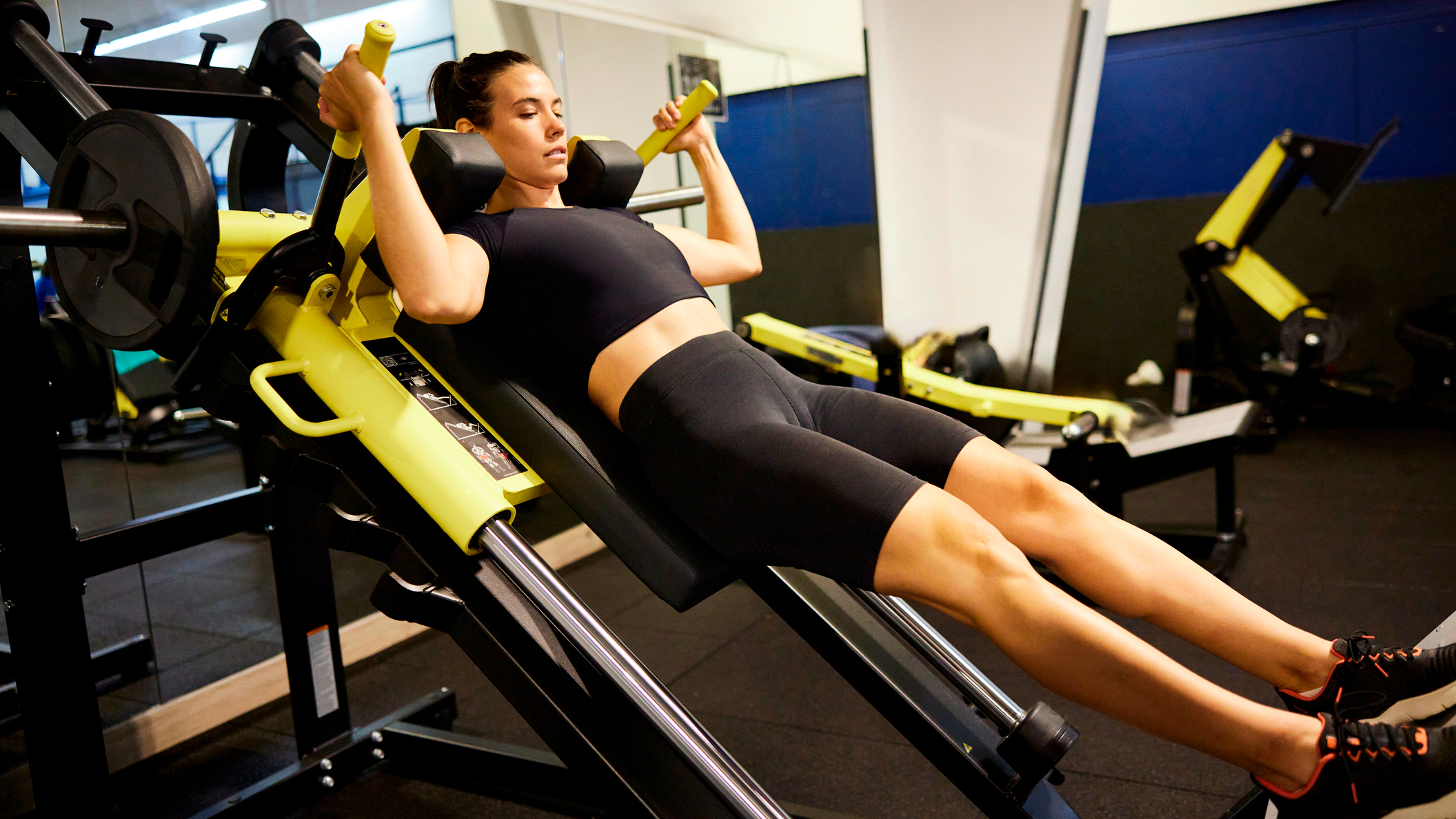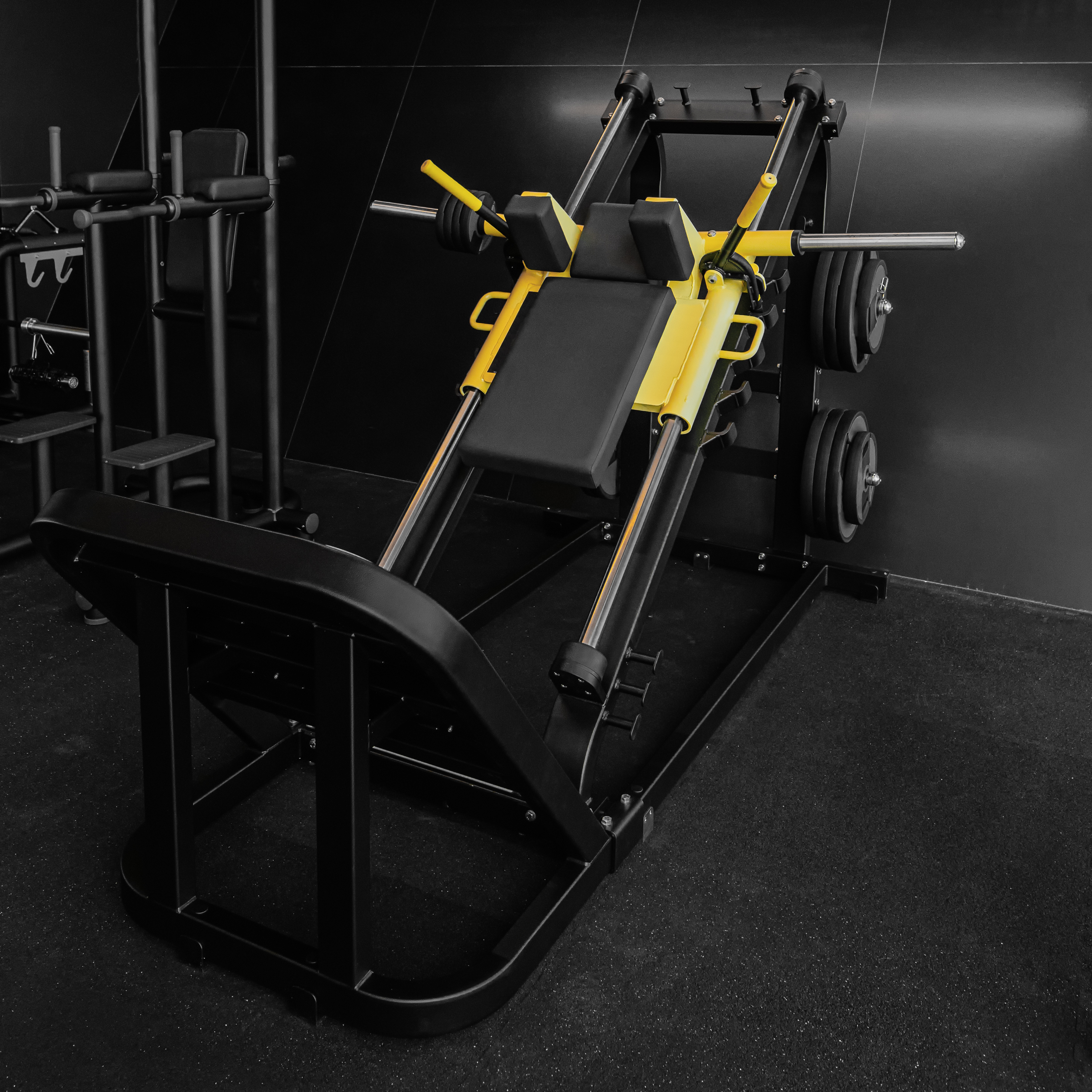
Squats come in a variety of shapes and sizes: the conventional (back squat, front squat), the advanced (overhead squat, squat clean) and the alternative (sumo squat, zombie squat). But one variation which may not be on your radar is the hack squat.
Popularized over a century ago and named after its creator, weightlifter and wrestler George Hackenschmidt, it allows you to squat a heavy weight without putting quite as much load through your spine. This makes it an attractive option for anyone with back issues.
It can be performed with either a barbell or a hack squat machine. Both methods target the large quadriceps muscles on the front of your thighs, and knowing how to master this technical lift could take your leg day gains to the next level while saving your back from the rigors of the squat rack.
To explore the ups and downs and dos and don’ts of the hack squat, we spoke to Eddie Baruta, global head of gym floor personal training at Ultimate Performance.
Barbell Hack Squat Vs Hack Squat Machine
What are the advantages of the barbell hack squat?
The barbell hack squat is a rear-loaded squat performed with the bar behind your legs. To the untrained eye it looks more like a backward deadlift than a squat.
The bar never rests on your shoulders, so the load you can shift will be limited by your grip strength. Nevertheless, you’ll be able to target your quads with more weight than you’d be able to with other free-weight exercises like goblet squats. “You’ll also be able to target your quads more directly than with an exercise like a barbell squat, which is more hip-dominant for most people,” says Baruta.
This shift in position of the bar also helps keep your torso more upright, taking pressure off your lower back. For anyone who struggles to keep the weight in their heels when squatting, this change of angle should also make it easier to drive through the midfoot and heel rather than the forefoot.
To assist this element further, especially if you have limited ankle mobility, it’s common practice to place two small weight plates or heel wedges under your heels when performing this exercise.

What are the advantages of the hack squat machine?
“In a word, it’s safer,” says Baruta. The machine version of the hack squat provides even more stability for your back, allowing you to really load up your quads. For this reason, it’s a go-to exercise for bodybuilders and anyone prioritizing hypertrophy over functional fitness.
Typically you will be lying at a 45˚ angle with your feet on a platform, pressing against pads resting on your shoulders. In this position, you still need to brace your core to transfer power from your lower to upper body, but there’s far less demand to stabilize your spine, meaning you can channel all your energy into powering up your quads.
Understanding these subtle differences should help when deciding if you should include it in your programming, says Baruta. “The free-weight version requires far more skill to execute. Your brain has to find out solutions to maneuver the bar behind your legs in an unfamiliar movement pattern.” As a result, your body will recruit more stabilizing muscles.
In contrast, the resistance machine provides added stability so you can channel all your energy into generating raw power. “You can create more intent with the platform,” says Baruta. “You can produce more output and as such stimulate the quad muscles much more effectively than with the free-weight hack squat.”
How To Do The Hack Squat
How To Do The Barbell Hack Squat
Stand with your feet shoulder-width apart and heels elevated on a pair of small weight plates or heel wedges. “The idea here is to enable your knees to travel forward to help target the quads,” says Baruta. “Elevating your heels allows for an upright torso, full knee flexion at the bottom of the movement and a straight bar path from start to finish.”
Baruta says it can be challenging to start this exercise from the floor. Instead he recommends setting the bar up in a squat rack positioned just lower than full arm length when standing. Start light as you familiarize yourself with the technique required to take the bar out of the rack and drop into the squat.
Start with your back to the racked bar, and drop into a partial squat to grasp the bar with an overhand grip, palms facing behind you. Retract and depress your shoulder blades to straighten your back, puff out your chest and inhale to brace your core. From here, keep your gaze focused in front of you and stand to lift the bar out of the rack.
With the bar clear of the rack, bend your knees to lower into a squat, allowing the bar to travel straight down, while keeping your torso upright. “When it’s executed correctly, your hips shouldn’t travel back,” says Baruta. “You want the barbell to move up and down vertically in a straight line, rather than have to travel around your legs.”
Bend your knees to lower as far as you feel comfortable. Don’t feel you need the bumper plates to tap the floor each rep. From the deepest position, drive through your midfoot and heels to return the bar to the start position in one smooth motion, exhaling as you stand. Once all reps are completed, carefully lower the bar into the rack.
How To Do The Resistance Machine Hack Squat
Hack squat machines vary, but in general this kit should comprise a fixed platform for your feet, a fixed backrest to take your weight and shoulder pads with handles to press against.
The platform should angle your feet optimally so there’s no need to raise your heels any further. Place your feet shoulder-width apart, grasp the handles and inhale to brace your core. Unlock the machine to take the weight, then bend your knees to lower slowly into a squat.
From here, drive through your midfoot and heel as you exhale to smoothly press your body away from the platform and straighten your legs. “Aim to flex your knee fully and maintain a neutral spine throughout,” says Baruta, adding that you ideally want to reach a squat depth that allows you to close the gap between your hamstrings and calves.
Another thing to consider with bilateral movements is joint stacking, he says. “When pushing, you have to align your ankle with your knee and your upper leg with your lower leg [rather than letting it travel in or out] to avoid any damage to the knee. To achieve this, you might need to widen your stance to allow for your biomechanics.”
Common Hack Squat Form Mistakes
Bouncing At The Bottom Of The Rep
For all the benefits of the fixed backrest, it can prove a problem for anyone with even slightly limited mobility in their ankles, knees or hips. That’s because at the bottom of a squat, it’s common for the lower back and tailbone to round, or curl under—known as a “butt wink” in bodybuilding circles.
When pushing considerable weight, this can compromise the vulnerable lumbar joints and risk common back problems like a slipped disc. A flat backrest exacerbates this risk because it alters the natural curvature of your spine.
The most important thing to bear in mind is to take extra care at the bottom of the hack squat exercise, says Baruta. Avoid “bouncing” in and out of this deep squat position, and focus on a controlled concentric and eccentric phase of the exercise.
Pressing Through The Forefoot
While elevating your heels with bumper plates allows you to target your quads effectively, your focus should still be pressing through the midfoot and heel throughout this exercise to avoid placing extra strain on your knee joint and the patella tendon.
If limited ankle mobility makes this feel impossible, try the resistance machine version of this exercise, or one of the hack squat variations listed below.
Hyperextending The Knee
Another all-too-common mistake Baruta warns against is overextending your legs at the top position of this exercise, whether performing it with a barbell or resistance machine. “Focus on moving throughout all phases of the lift with control,” he says. Don’t rush your reps or snap into a hyperextended position at the top of the exercise.
Hack Squat Progressions, Regressions And Variations
Wall sit
A beginner-friendly regression, this isolation exercise replicates the 90˚ knee bend and upright torso technique required in the bottom of the hack squat. Lean against a wall with your feet shoulder-width apart, heels down. Slide down the wall until your thighs are parallel with the floor, keeping your back in contact with the wall and core and glutes engaged. Hold this position, breathing normally as long as your thighs will allow.
Kettlebell hack squat
An advanced progression, this free-weight exercise demands immense control, balance, mobility and should be considered only if your knees have a clean bill of health. Rather than using weight plates under your heels, the goal is to perform this full move with heels elevated off the floor, balancing on the balls of your feet. Keep your feet close together and hold one kettlebell behind you in both hands. With heels lifted, slowly lower until your knees are bent 90˚, then drive up to stand.
Bodyweight hack squat
This is a slight regression on the kettlebell version. Perform the same exercise, with heels elevated throughout and your weight balanced on the balls of your feet, but without the added load of a kettlebell. Only when you can flawlessly execute three sets of 10 reps should you carefully begin to introduce weight.
Sissy squat
This is another advanced quad-focused exercise that can be performed with just your bodyweight, or with a sissy squat machine, which can be found in most commercial gyms. For the machine version, position your calves firmly against the rest and your feet locked in tight to the shin pad. Lean back slightly to place tension on your quads, then slowly lower into a squat until your knees bend 90˚. Engage your quads to straighten up again, but keep leaning back slightly to maintain tension in the front of your thighs.
Leg extension
“The hack squat targets the quad muscles in their mid range,” says Baruta, noting that it generates a different stimulus than experienced with quad isolation exercises like the leg extension.
Sit up straight with your back tight to the backrest and knee in line with the machine’s pivot point. Position the pad on top of your shins, keeping your ankles in a neutral position rather than dorsiflexing your feet. Maintain a greater than 90˚ bend at your hips so that you can effectively target the quads through their full range. From this here, squeeze your quads to extend your legs, pause, then slowly return to the starting position.







